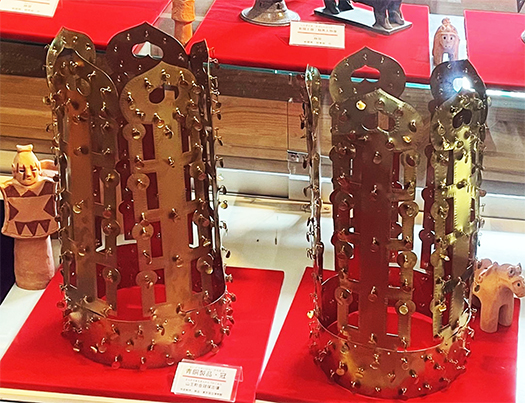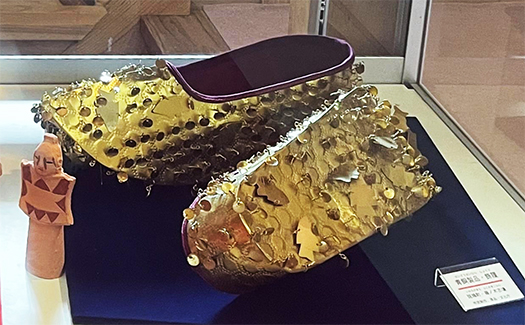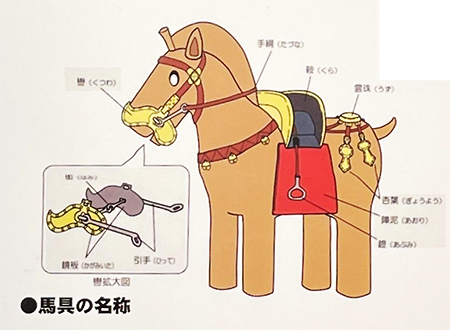


日本の王権、皇室儀式にはいまも農業祭祀が色濃い。
弥生時代から王権の「東征」という事態が進行して
奈良盆地・纏向遺跡には3世紀中頃、250年代には到達していたと思う。
日本武尊の東国遠征という説話は、畿内地域での水田開発農業革命の成功から
さらに東国にそれを拡大させていく志向性の表現か。
そのことには鉄器の利用と水利農業土木技術がセットになっていただろう。
初期の水田耕作、土木改良については鉄器利用が最大の技術革新。
古墳の造営という宗教文化も、水利土木技術力を表現している。
飛鳥では苑池で「噴水」を実現するまでの技術力。
その土木工事の起動力たる鉄器はヤマト王権最大の「武器」だったことだろう。
現実に征服域を拡大させるには現地在地勢力を
鉄製武力で圧倒する必要もあったことだろう。
やがて日本刀を生み出す技術蓄積は古代から営々と築かれてきた。
ヤマト政権と一体となった上毛野氏は、そういう経済・軍事が一体化した
圧倒的侵攻力で土地利権を獲得していったのではないか。
この時代の経済条件を一変させるような「技術革新」進出だったのだと。
現実に農業鉄器(スキやクワ)道具は権力側が占有管理していたとされる。
鉄が日本列島内で生産されなかった時代にはその供給源として
韓半島地域が「経済安保」上の必須地域だったのだ。
日本の古代王権がなぜに韓半島の政治情勢に敏感に反応したか、
その実質はこうした事情だと推測できる。
そういう「鉄器支配」の視覚化が上の写真のような権力者衣装。
金ピカの王冠や靴などのキッチュぶりは「鉄の支配者」を表現していたか。
そしてもうひとつが戦争の軍事力としての「ウマ」。
鉄とウマという2大パワーで、自然崇拝型の暮らし段階の人々を
その権力下に集約していったのが実態と思われる。
もちろんウマは平時には農業生産力として「馬力」を発揮もした。
日本列島に馬が登場するのは古墳時代中ごろ、西暦5世紀のはじめ頃といわれる。
有名な『魏志倭人伝』にも弥生時代の日本に「馬なし」と記述がある。
競走馬理化学研究所とネブラスカ大学などのチームが日本在来馬8品種と
世界の32品種のDNAを比較し日本在来馬はモンゴル在来馬の祖先が
対馬を経由して輸入され、全国に広がった事がわかったのだという。
この「大室古墳」地域にはウマの埴輪がこれでもかと展示されている。
「まつろわぬ」板東の民にしてみると、こういう経済力に圧倒され、
土地の生産性を飛躍的に高めるワンセットの文明パワーと見えたに違いない。
明治期の北海道開拓をはるかに超える民族体験。
高温多湿という豊かな気候条件に恵まれ、人口密度も低かった板東の地域は
東アジア世界でも有数のフロンティアだった。
English version⬇
Japanese Kingship’s Strategy to Expand into the “Bando” Region: Exploring the “Kamitukeno Clan”-4
The power of iron tools, horsepower, and hydraulic and civil engineering to promote production and the economy dramatically increased agricultural productivity, and the idea of single-mindedness took root. …
Japanese royal and imperial rituals are still heavily influenced by agricultural rituals.
From the Yayoi period, the situation of the “Eastern Expedition” of the royal power progressed.
I believe that the Mimamukai site in the Nara Basin was reached in the middle of the 3rd century, in the 250s.
The story of the expedition to the east by the Japanese military leader Takemikazuchi is based on the success of the paddy field development and agricultural revolution in the Kinai region and its further expansion to the east.
The expedition to the east of Japan may be an expression of the desire to expand the success of the paddy field development agricultural revolution in the Kinai region to the east.
This would have involved the use of iron tools and water-use agricultural civil engineering technology.
The use of iron tools was the greatest technological innovation in early rice paddy cultivation and civil engineering improvements.
The religious culture of building kofun (burial mounds) also expresses the water-utilizing civil engineering technology capability.
In Asuka, the technological power went so far as to realize a “fountain” in a garden pond.
Iron tools, the driving force behind civil engineering, were probably the greatest “weapon” of the Yamato kingdom.
In order to expand the area of conquest in reality, it was necessary to overwhelm local forces with iron military might.
In order to expand the conquered area, it would have been necessary to overwhelm the local forces with iron military power.
The technical accumulation that would eventually produce the Japanese sword was built up over time since ancient times.
The Kamomono clan, which became one with the Yamato regime, was able to combine its economic and military power
The Jomuno clan, which was united with the Yamato regime, may have acquired land concessions through overwhelming invasive power.
It was a “technological revolution” that transformed the economic conditions of the period.
In reality, it is said that agricultural iron tools (suki and kuwa) were occupied and controlled by the powerful side.
When iron was not produced in the Japanese archipelago, the Korean peninsula was used as a source of supply.
The Korean peninsula was an essential region for “economic security” during the period when iron was not produced in the Japanese archipelago.
It is possible to speculate why Japan’s ancient kings were so sensitive to the political situation in the Korean peninsula.
The real reason for this can be inferred from this situation.
The visualization of such “iron rule” is the power costume shown in the photo above.
The kitschiness of the gilded crown and shoes may have been an expression of the “iron rulers.
Another is the “horse” as a military force in war.
The iron and the horse are the two major powers that brought the people in the nature-worshipping stage of life together under the power of the iron and the horse.
The reality seems to be that the two major powers, iron and horses, were used to consolidate people in the nature-worshipping stage of life under their power.
Of course, in times of peace, the horse also demonstrated its “horsepower” as an agricultural production force.
It is said that horses appeared in the Japanese archipelago around the middle of the Kofun period, at the beginning of the 5th century AD.
The famous “Biography of Wei Wei” also mentions that there were “no horses” in Japan during the Yayoi period.
A team from the Institute of Physical and Chemical Research for Racehorses, the University of Nebraska, and others compared the DNA of eight breeds of native Japanese horses with that of 32 breeds from around the world.
The team compared the DNA of eight breeds of native Japanese horses with that of 32 breeds from around the world, and found that the ancestors of the Mongolian native horses were imported via Tsushima.
They found that Japanese native horses were imported from Mongolia via Tsushima and spread throughout Japan.
In the Omuro Kofun area, there are many horse haniwa (terra-cotta tomb figurines) on display.
The people of Bando were overwhelmed by this kind of economic power.
The people of Bando must have been overwhelmed by this kind of economic power, and must have seen it as a set of civilization power that dramatically increased the productivity of the land.
The experience of the people far exceeded the development of Hokkaido during the Meiji period.
Blessed with rich climatic conditions of high temperature and humidity, and low population density, the Bando region was
It was one of the most prominent frontiers in the East Asian world.
Posted on 8月 13th, 2022 by 三木 奎吾
Filed under: 日本社会・文化研究, 歴史探訪







コメントを投稿
「※誹謗中傷や、悪意のある書き込み、営利目的などのコメントを防ぐために、投稿された全てのコメントは一時的に保留されますのでご了承ください。」
You must be logged in to post a comment.